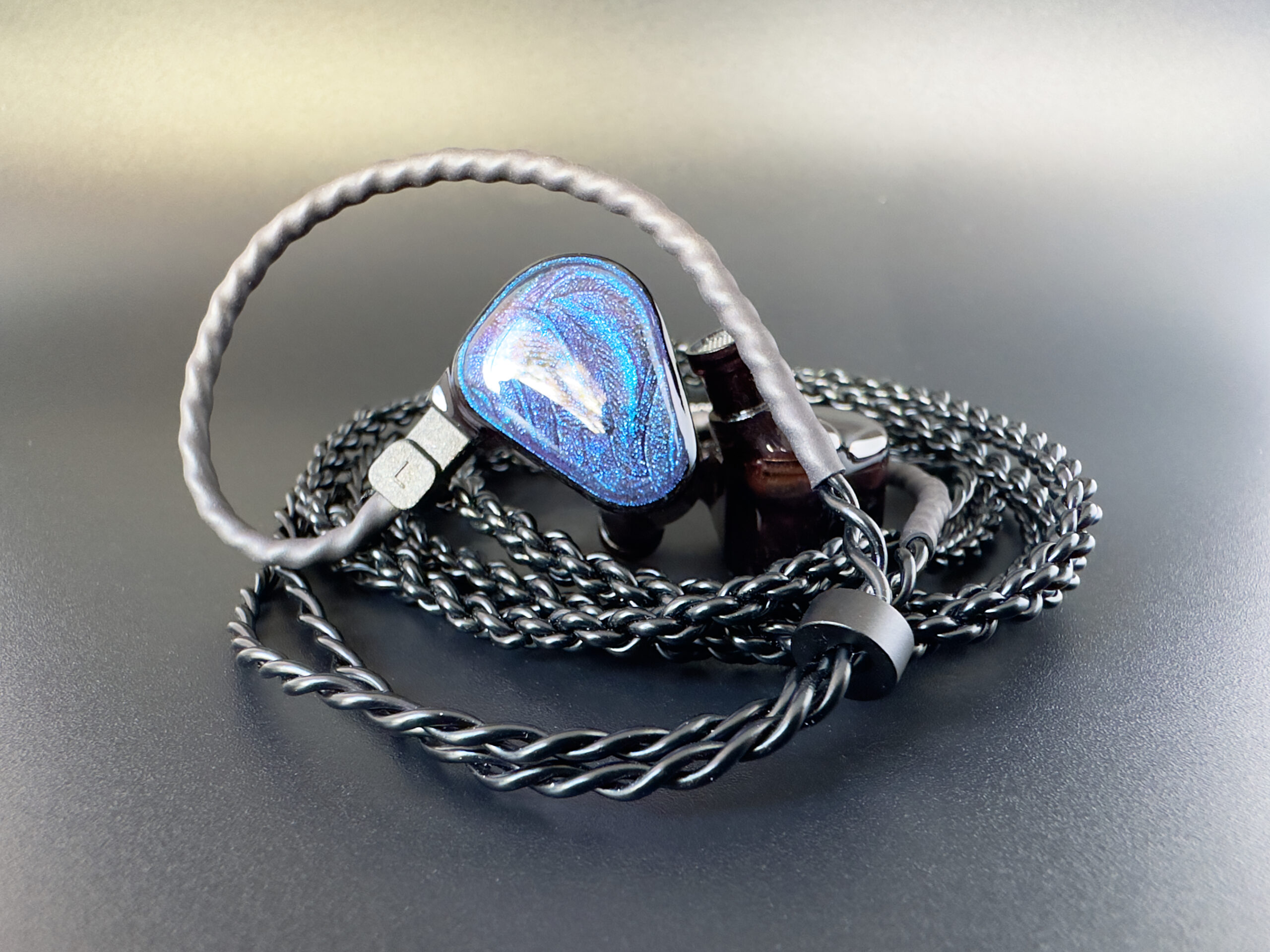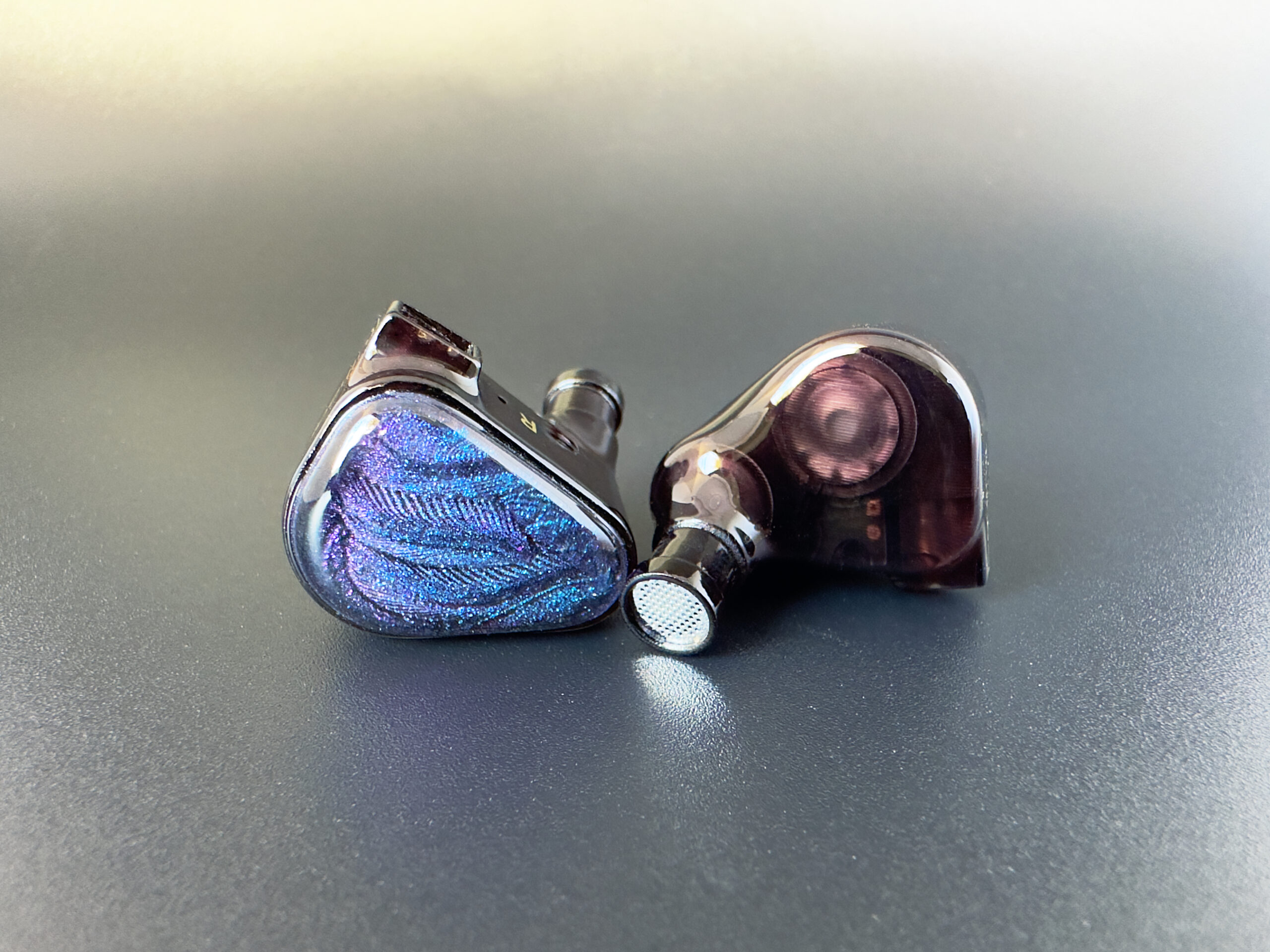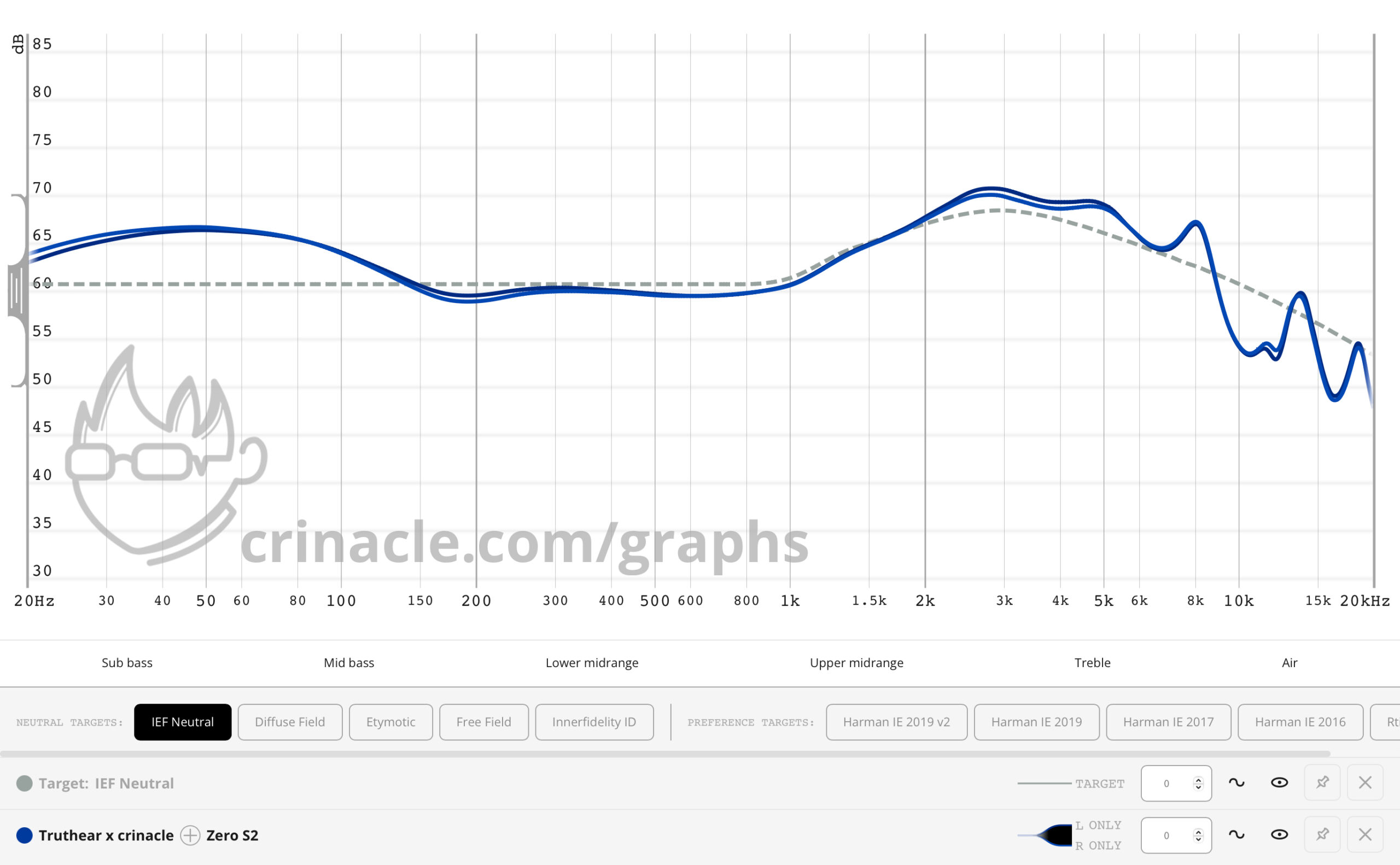
Intro
This is an interesting one.
The Zero is Truthear’s first IEM. AND it also has two dynamic drivers – one is specifically only for bass – which is a very unusual configuration. AND it’s also tuned to the Harman Target (more on that later). If that wasn’t enough, it is a collaboration with Crinacle.
The combination of all of these things is pretty rare, so for $50 is it any good? Keep reading to find out.

Tech Specs
Driver Configuration: 10mm + 7.8mm Dynamic Driver
Diaphragm Material: PU + LCP Composite
Sensitivity: 117.5dB/v @ 1kHz
Impedance: 10Ω
Frequency Response: 20Hz- 39,500kHz
Connector: 0.78mm 2 Pin

What’s in the Box?
The box is small to medium sized and minimal. It’s a good size for IEMs and doesn’t seem to create too much waste, especially compared to other IEM packages.
Inside there is a leatherette pouch that contains the cable. The pouch is nice quality, but I’d prefer a small case to a pouch…but to each their own. I could see some people really loving the pouch, so I can’t complain too much here. Plus, for the overall price, corners have to be cut and I’d rather it be here than the IEMs!
For the price, the cable is pretty nice. In this price range, it would be hard to find a better cable and most aren’t even this good. To nitpick, it is a little light, thin, and tends to knot-up. But again, it’s better than almost anything you’d get for under $50.
The Zero also comes with quite the selection of ear tips, nicely arranged on a plastic card. This little presentation is very nice and helps make the Zero feel even more premium than it is – which I always see as a good thing! It comes with 3 pairs of small bore (SML) silicone tips, 3 pairs of wide bore (SML) silicone tips, and one set of medium foam ear tips.
The IEMs themselves are very impressive. They’re made from DLP 3D printing and medical grade resin. While these materials aren’t anything new or exotic, they’re done to absolute perfection. The entire surface of the Zeros are unbelievably smooth, yet aren’t slippery to hold. Everything is beautifully rounded, there’s not a hint of sharp edges or seams. Clearly a lot of attention to detail went into the manufacturing of the Zero and it really shows. The faceplates on the Zero are absolutely spectacular. Photos really don’t do these justice. They have a sparkly blue swirl look that morphs to purple depending on how the light plays with the surface – absolutely gorgeous.
Fit, Comfort, & Isolation
While the Zeros are exquisitely made, they are pretty chonky and thick. They stick out quite a bit from the ears, which can be a problem for some. However, weighing in at 5.1 grams, they’re very light, so this helps alleviate some of this issue. The nozzles are also ginormous with a diameter of 7mm. The size of the Zeros themselves have a medium depth fit, however that is hard to accomplish with the thick nozzles. Luckily, I had some Spinfit CP155 ear tips, and any issue of comfort was relieved.

Sound
Overall
As mentioned before, the Zero is tuned to the Harman Target, which is virtually unheard of in this price bracket. To oversimplify, the Harman Target was scientifically developed to sound the best to most people and is a very unique tuning if you are used to listening to consumer tunings (deep v-shaped signatures). People tend to either love this or hate it, with hardly any in-between. I just so happen to love the Zero’s version of Harman. Overall, the Zero emphasizes sub bass and upper mids.

Bass
Normally I would say this bass is the star of the show, but in reality, it contributes to the entirety of the Zero. The larger 10mm dynamic driver is used only for bass below 200Hz – in effect, making this driver a subwoofer. As you can see by the frequency response graph, the bass is well “tucked-in” from the mids and only starts at that 200Hz mark – this is one of the hallmarks of Harman Tuning. Because of this, it helps emphasize mid bass and sub bass, even though the sub bass has some roll off at the end. However, the sub bass roll off actually works here and helps keep the bass from becoming too overpowering. The tucked nature also helps give more contrast to the flat lower mids, essentially helping the bass sound more boosted than it actually is. It also helps the bass hold back from blooming at all into any of the lower mids – it’s like a wall is up between the two and there is absolutely no mixing.
The bass is pretty fast for a dynamic driver and recovers almost as fast, although it’s nothing compared to a planar driver here, and it is very well done for a dynamic driver. The sub bass and mid bass are definitely present and provide a great bass listening experience without becoming overwhelming. However, with the hard tuck at 200Hz, thump or slam isn’t in the Zero’s repertoire. This is very clean and analytical bass with a hint of boost.
As I hinted before, I’d go as far as to say that the bass in the Zero is like a well tuned subwoofer in a hifi system – it adds to the complete system without being overbearing. This is really an accomplishment for Truthear and I can only hope that more IEM manufacturers take note of a dedicated, well-tuned subwoofer driver.
Mids
The mids are the next logical step to talk about after the bass “tuck.” As I mentioned in the bass section, the bass is completely cut-off from the lower mids. This provides the mid range with an extremely clean presentation, free of any mid bass bleed. In fact, the mids can sound a little bright or analytical across the mid-range frequencies because of the clean cut off of the bass. However, the pinna gain is without sibilance or harshness and very well done.
However, if you prefer warm male vocals, the Zero isn’t for you. While male and female vocals sound very natural and correct, they do not have any added warmth to them, which is in line with an analytical style sound signature. I actually prefer this style of mids and talking about a lack of warmth is an incredibly small nitpick, especially for the asking price. In fact, I’m having a hard time coming up with anything negative to say about the mids – they’re really good.
Treble
The Zero’s treble extends very well, which is very surprising for a dynamic driver under $100-$150. However, there’s not a whole lot of airiness to the treble either. The treble is well detailed and sounds very natural, at the cost of airiness and upper harmonics. Just like the other sections in this review, anything bad I have to say here is just a nitpick and it’s hard to fault the treble for the price – in fact, it’s great.

Technicalities
To my ears, these two dynamic drivers have great timbre and everything from sub bass, kick drums, vocals, distorted guitars, violins, and pianos all sound very natural and life-like – in my testing nothing stood out as sounding even a hint unnatural.
All over the internet, reviews are saying that the technical abilities of the Zero are either terrible or pretty darn good and punch above their weight. While I was initially confused by the conflicting information, I accidentally found out why.
When I was listening to the Zeros with my old Fiio BTR3, details were terrible, instrument separation was almost non-existent, and the soundstage was all smeared together – and no, it wasn’t bluetooth causing the issue. However, switching to the Fiio KA3, the Fiio Q1 Mark II, and the Quedelix 5K, all of these technicality issues completely went away and the Zero really sang. I found out that the unfortunate BTR3 only had 25mW of power, which apparently isn’t enough for the Zero. For the first time in my years of audiophiledom, I can say that the Zero is very source-dependent and needs some power to reach its full potential. If it’s not sounding great, it might be time to reach for a more powerful source.
Once properly powered, details came alive across the board. Bass had texture, detail, and speed. The mids rang clear as a bell, and the treble became a little better extended and detailed as well. Micro details are absolutely phenomenal for the price. These compete 90% with the Olina and Kato in terms of micro details, which are 2x and almost 4x (respectively) the cost of the Zero. Impressive.
The soundstage is a bit confusing to me however. On most of my soundstage test tracks, the Zero performed very average at best. However, on some tracks that I don’t use for soundstage, it was massive, wide and outside of my head – which is completely abnormal for these tracks. Maybe the Harman target is playing weirdly with my ear canals? So while the soundstage is average, it’s also great when it’s not expected.
Instrument separation is above average (ie: fantastic for the price), and the separate bass driver really lets instruments and vocals in the mids and treble stand out on their own.

Conclusion
Somehow Truthear stepped up to bat for the very first time and hit a grand slam. It seems they did the impossible on their very first attempt with the help of Crinacle. I hope more manufacturers are taking note on how to have a separate subwoofer driver and exceptional tuning for a very reasonable price. Just like planar drivers are the future, I can see a place for dedicated subwoofer dynamic drivers as well.
The Truthear Zero is a no-brainer, easy recommendation for the budding audiophile, with the only caveat being the massive nozzles.
It’s an absolute triumph Truthear – well done.
